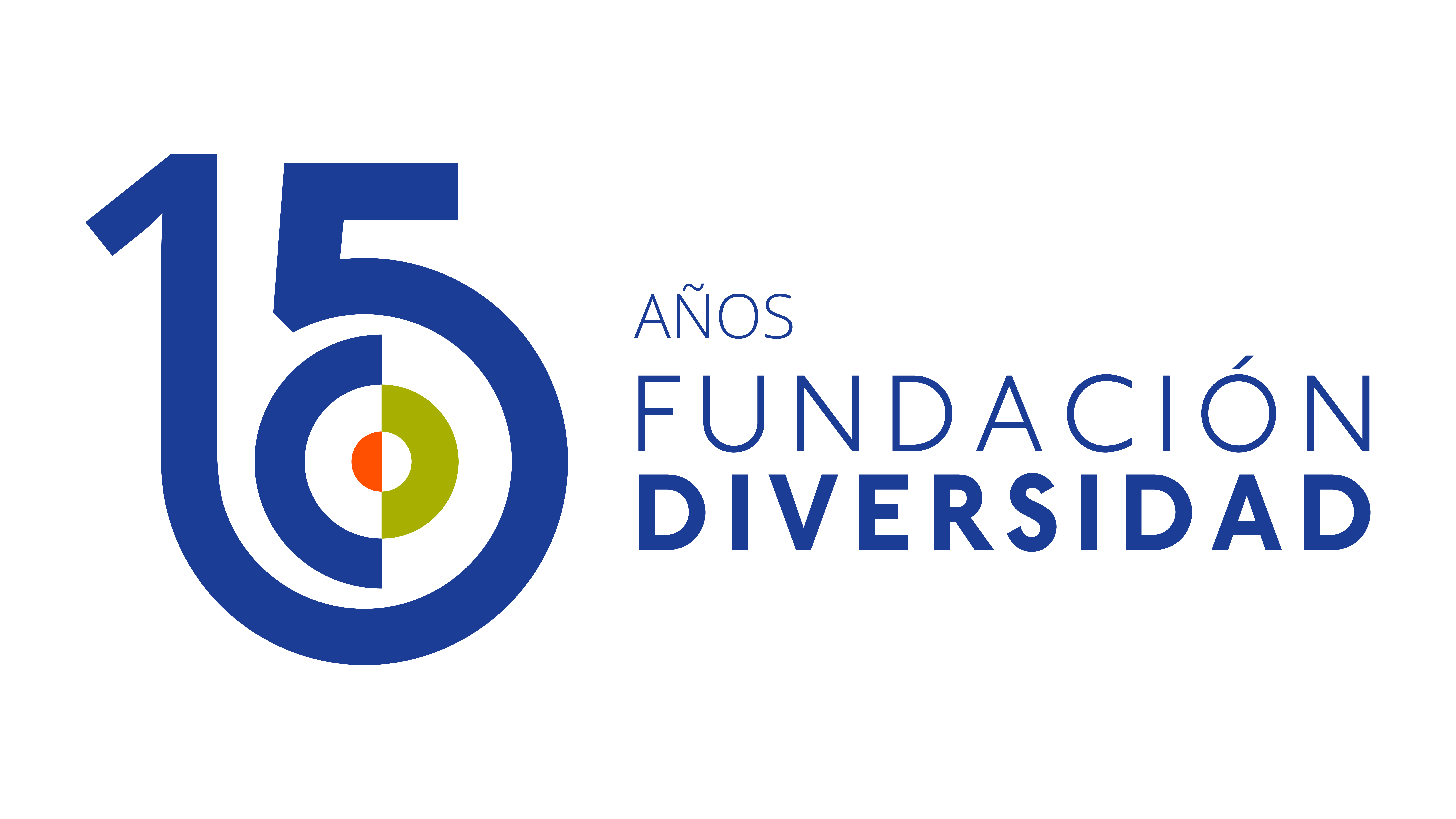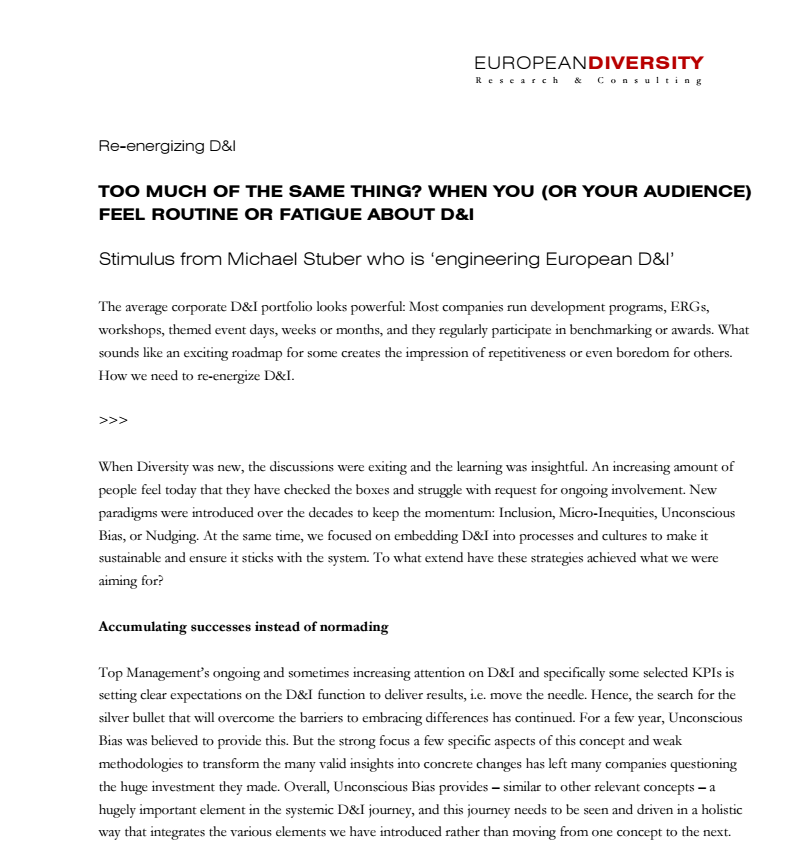Re-energizing D&I
TOO MUCH OF THE SAME THING? WHEN YOU (OR YOUR AUDIENCE) FEEL ROUTINE OR FATIGUE ABOUT D&I
Stimulus from Michael Stuber who is ‘engineering European D&I’
The average corporate D&I portfolio looks powerful: Most companies run development programs, ERGs, workshops, themed event days, weeks or months, and they regularly participate in benchmarking or awards. What sounds like an exciting roadmap for some creates the impression of repetitiveness or even boredom for others. How we need to re-energize D&I.
When Diversity was new, the discussions were exiting and the learning was insightful. An increasing amount of people feel today that they have checked the boxes and struggle with request for ongoing involvement. New paradigms were introduced over the decades to keep the momentum: Inclusion, Micro-Inequities, Unconscious Bias, or Nudging. At the same time, we focused on embedding D&I into processes and cultures to make it sustainable and ensure it sticks with the system. To what extend have these strategies achieved what we were aiming for?
Accumulating successes instead of normading
Top Management’s ongoing and sometimes increasing attention on D&I and specifically some selected KPIs is setting clear expectations on the D&I function to deliver results, i.e. move the needle. Hence, the search for the silver bullet that will overcome the barriers to embracing differences has continued. For a few year, Unconscious Bias was believed to provide this. But the strong focus a few specific aspects of this concept and weak methodologies to transform the many valid insights into concrete changes has left many companies questioning the huge investment they made. Overall, Unconscious Bias provides – similar to other relevant concepts – a hugely important element in the systemic D&I journey, and this journey needs to be seen and driven in a holistic way that integrates the various elements we have introduced rather than moving from one concept to the next.
The danger of invisibility
Embedding D&I into policies and processes has probably been the strongest and most promising D&I approach to ensure systemic impact. However, some unwanted side-effects of this strategy included
- Reducing or abandoning D&I functions or councils once it was plugged in into leadership models and accountability
- Reducing or stopping D&I campaigns, communication or event as other formats were supposed to convey D&I-related messages implicitly
Many organizations were then left with a skeleton D&I department coordinating the remaining topic-specific activities such as ERGs, support programs or awareness weeks. Hence, the perception of D&I reverted to crystalize around the traditional focus on disadvantaged groups while the ‘embedding strategy’ made the topic largely invisible in many or most places. Quite often, D&I had not become everybody’s responsibility ended up being no-one’s responsibility.
All this does not mean, however, that our approaches were ineffective, let alone wrong. It does show a need, though, to reconsider our portfolios, our pitches or some of the connections we offer.
How to re-energize D&I by adjusting your positioning, alignment and revamp your business case
Most corporate D&I missions include the notion of change. However, many of the programs and initiatives described at the beginning of this article, are not designed to changing the workplace or business reality. Hence, the first recommendation to re-energize D&I is to bring back the change into your D&I positioning. When the understanding D&I focuses on facilitating change, your recurring annual activities and household programs will serve a clearer purpose and will be perceived more powerful.
Admittedly, many corporations are extremely successful and therefore typically accept that they can always improve further while they may not see a need for more fundamental change(s). Therefore, making D&I relevant and tangible to the business is the second recommendation. A clear and rigorous alignment of your D&I storyline and strategy with the business goals, priorities and also challenges encourages buy-in from management – but it needs to be specific and concrete, for example by facilitation strategy workshops with business units, regional or country organizations and global functions rather than trying to make one size fit all.
Being able to work on a change agenda with key audiences requires more than a desire to comply and do the right thing. Hence, the third recommendation is to be stronger and clearer on the value that D&I-related change adds. Here, one headline has to be: No Return without investment. For the expectations for both business benefits and measurable progress on KPIs can only be met if the delivery framework is there – including the resources.
A more in-depth description of building your business case can be found here:
http://en.diversitymine.eu/if-you-think-your-business-case-for-diversity-is-robust-think-again/
The article is based on a three-parted opening key-note at the World D&I Congress – the so-called Mumbai Trilogy “Who are we? The Future of D&I”
Part 1: http://en.diversitymine.eu/di-could-be-a-powerful-alternative-to-nationalism-if-pitched-effectively/
Part 2: http://en.diversitymine.eu/di-must-step-out-of-its-own-comfort-zone/
Part 3: http://en.diversitymine.eu/how-di-leaders-should-be-di-role-models-and-work-more-with-the-mainstream-majority/




